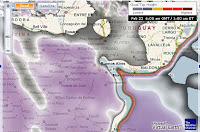As it is usually the case with e-mailing lists, topics occasionally reoccur for the benefit of the new members. And so it was recently with
Tango-L, a list "for discussion of any aspect of the Argentine Tango." Discussion about what is and what is not tango, or tango nuevo, or alternative milongas and all that raised its head once more.
Then a related topic was touched briefly about the evolving art of tango and what is so special about the relationship between Buenos Aires and tango. One post caught my attention. It was by Dierdre N. Black I reproduce it here with Dierdre's permission.
Well, let's see....where to begin? First of all, as a professional ballet/contemporary dancer, for a large portion of my life, I appreciate that dance needs to be a "lively art" and therefore, continually evolving, changing and reflecting, to a large extent, cultural/era specificities(such as: "cargo pants" vs "tango suits", etc.).....I'm definitely down with that concept! Yet, today, we are still able to enjoy the great, classical ballets, frozen in time, as well as the most contemporary and avant garde ones and they are all called "ballet". Supposedly, the Finnish tango is "frozen" in the tango of the twenties and they have no interest in evolving their style. Is this a more "real tango" because it hasn't changed, for almost 100 years? Or is "it" more from contemporary pilgrims/portenos, living in BA, evolving the dance, daily; sometimes(depending), dancing tango in cargo pants, flip flops and to Elvis Presley, others, in the little black dress, high heels and to Troilo? Who's to say? Both of these views of tango(plus the entire continuum between)are valid, here and worth considering, in this discussion, I feel.
Perhaps, we are asking the wrong questions. Perhaps, tango afficionados are missing the point and think they only come to BA to dance "the real, classic Argentine tango", to find that, instead, there is a lively art, here, changing with the times/fashions/artists, like any other viable art will do and maybe, looking for the "real tango", in BA, is like trying to know the sound of one hand clapping. Instead, after living here for three, amazing years, I have found that the tango is sooo much more than just a dance(or specific "style", thereof)...the actual dance appears to be merely the "tip of the tango iceberg", if you will. Instead, you will find the "real tango" in the blood of the rioplatense(Uruguayos, tambien/Montevideo)people, being expressed daily, in their attitudes, customs, desires, food, wine, humor, rhythms of life(even tho they don't dance a lick), as well as in the glorious, hothouse world of musicians, dancers, singers, composers, of the tango classico. The dance does not exist in an artistic vacuum but rather, in the context of this culture and that is what, in the end, I believe people come here, for...to "feel the tango" context, rather than determine a "perfect style". In fact the more you are here, the more open that definition becomes. If there IS any one, consistent element that continues to run through all these discussions, though, it's the "connection" of tango that people seek, within themselves and each other and BA provides that constant feeling of connection, with your family, neighbors, dance buds and "the BA life", from whence this seductive dance comes. There's nothing like "swimming in the BA soup for awhile" just to make your tango more juicy, soulful and connected, no matter what style you prefer. Also, not just attending classes and milongas, while here but going to theatre, opera, poetry readings, tango music/singer performances(no dancing), art/photog shows, will make your tango dancing better..... not necessarily more classic, flashier, better technically or even more nuevo(2-3 weeks simply isn't enough to accomplish that, even with intensives)but more importantly, you can go away with "many more miles" and a more organic center/perspective that can't be replicated anywhere else. You can experience directly, the cultural position that the dance of tango inhabits, in this warm, sensual city/country(and Uruguay, btw). Then, your personal style merely becomes the "icing on your tango cake".
Besos y abrazos, Dierdre N. Black
 It was really a very nice weekend tango escape with a great group of friends from Tallahassee, Gainesville, Tampa area and anywhere in between.
It was really a very nice weekend tango escape with a great group of friends from Tallahassee, Gainesville, Tampa area and anywhere in between.





